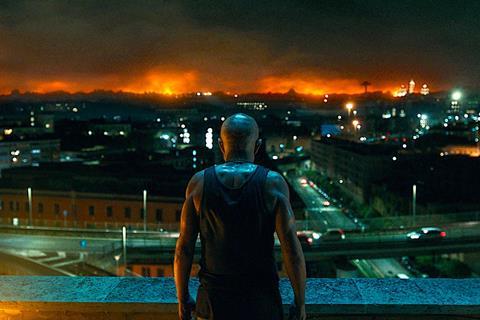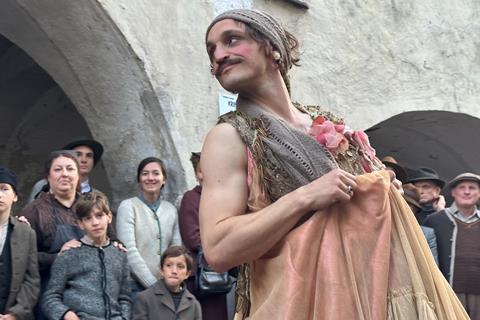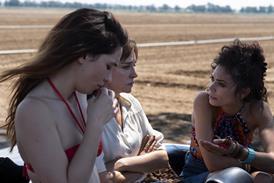
Cast an eye over the titles vying for a Golden Lion at this year’s Venice Film Festival and one thing stands out – the number of Italian films in the main competition.
Six of the 23 films in the main competition are Italian, an increase from the usual three Italian titles that are programmed in the section. While the step change could be a result of the writers and actors’ strikes leading to fewer US productions making the trip to Venice, each of the selected Italian films had been strongly tipped for a competition slot ahead of the festival.
The growth is more likely a consequence of changes in Italian cinema production, which has been transformed in the six years since Italy’s New Cinema Law was passed in 2017 (see below for details).

The changes are apparent in the six films in competition. They include Edoardo De Angelis’s big-budget festival opener Comandante, a Second World War submarine story inspired by true events. Films on the scale of Comandante used to be shot in Cinecittà by Hollywood companies, but now the Italian industry seems up to the task of producing them itself.
Revenge tale Adagio comes from Italy’s leading action filmmaker Stefano Sollima, who brought a new approach to Italian TV production with the series Romanzo Criminale and Gomorrah before going on to direct films both in Italy and in Hollywood (Soldado, Without Remorse).
Italian filmmaker Matteo Garrone attends with migration drama Io Capitano, while arthouse director Giorgio Diritti brings his fifth film, period drama Lubo starring Franz Rogowski. Diritti’s international status was enhanced after Hidden Away won the best actor prize for Elio Germano at the 2020 Berlinale.
Saverio Costanzo, the creator of acclaimed Netflix series My Brilliant Friend, premieres Finally Dawn. Meanwhile, Enea is the second film from Pietro Castellitto (son of actor Sergio Castellitto, who also acts in the film), who demonstrated a unique and non-traditional take on comedy with his debut feature Predators, winner of the Venice Horizons best screenplay award in 2020.
Rising budgets

One of the biggest changes for all of these films is in terms of budgets. The cheapest of the Italian titles in competition is Lubo with a €7m budget while the most expensive is Finally Dawn at €28m – a huge sum for an Italian production (figures are according to Italy’s Ministry of Culture).
Back in 2015 Nanni Moretti’s My Mother’s €8m budget was considered almost outrageous, while two years ago, Gabriele Mainetti’s €15m feature Freaks Out, also presented in competition in Venice, was regarded as something of a unicorn; Italy was just not used to producing films at these budget levels.
Now, however, higher budgets look here to stay. “Not only the big pictures but even the average costs for a comedy have risen,” says Wildside CEO Mario Gianani.
Higher budgets are not just confined to Venice titles. Budgets for all Italian films have grown. This was one of the aims of the 2017 Cinema Law, which has taken a few years to bed in. As well as stabilising the 30% tax credit, which allows for better and safer planning, the law introduced a new cinema fund that is partly financed from VAT taxes paid by productions. The more films that are produced, the more this fund grows for the next year.
In addition, the arrival of new players in Italy – in large part, the streamers: Netflix, Disney+ and Prime Video – has driven up competition and production budgets. As Gianani points out: “The arrival in Italy of new players has created more demand for films, with a logical growth in costs because resources have yet to grow in proportion. Competition has inflated how much everybody is paid. Last year we struggled to find hairdressers!”

Currently, the average budget for an Italian film is around €6m, while big productions cost between €10-15m and the biggest movies, like Finally Dawn, cost even more.
Enea director Pietro Castellitto recognises that he has been a beneficiary of the growth in budgets. “I think it says something about the Italian industry that a 30 year-old is permitted this budget. I don’t know how many producers in Europe would have given €8m to a guy after having made just one film.”
International dimension
The growing number of Hollywood and international productions shooting in Italy has also brought in expertise and helped build technical skills in a country already famous for its filmmaking craft. Adagio, for example, has visual effects by EDI, the leading Italian company for digital effects which also works with Disney and Warner Bros on projects such as Thor: Ragnarok and Black Adam.
Cinecittà has become a symbol for how busy the Italian film industry has become, as Saverio Costanzo recalls: “When I started my career, Cinecittà was a semi-deserted place for TV productions. When we shot Finally Dawn, it was alive, full of cinema productions, both Italian and international.”
Reflecting the new international dimension to Italian filmmaking, Finally Dawn is produced by Wildside, part of European superindie group Fremantle. Fremantle also owns The Apartment, producer of two other Venice competition titles: Enea and Adagio.

A major issue facing Italian films, however, is that the country’s box office hasn’t recovered to a level than can sustain rising costs. Admissions for 2022 were down 50% compared to the average between 2017 and 2019. So far this year, admissions are still down 30% compared to the same period in 2019, according to box office organisation Cinetel.
Italian films haven’t been doing much to help: the country’s share of 2023 box office so far stands at 20%. It used to hit 30% in the best years before the pandemic.
Against this backdrop, Italian films like those in competition at Venice are looking abroad to make a return. As Gianani says: “At Fremantle we know very well that a rise in quality brings a rise in international sales.”
Little wonder then that many of them are outward looking. Lubo is an Italian-Swiss co-production starring one of Europe’s hottest actors, Franz Rogowski, while Finally Dawn stars Lily James and Joe Keery. Comandante and Adagio are both genre films (a war story and gangster feature respectively) which lend themselves more to international audiences.
Too many films

One of the few missteps of the New Cinema Law is that, while it has allowed many more films to be made, many of these titles have little prospect of finding an audience. Italian productions numbered 251 in 2022, 30% more compared to the 2017-2019 period average, according to Cinetel.
“There can’t be that many films, it means a lot of those haven’t got the space to be seen,” says Saverio Costanzo. “And if you are producing without the possibility of being seen, then you’re just trying to have a profit for yourself without making a career for those who are working in the movie.
“A lot of these movies don’t even get distributed. I think we need to be more careful with production.”
To stand out, these Venice movies are looking to create a splash. Some, like Adagio, are set for a prestige Christmas release date in Italy, others like Comandante are planning a significant marketing campaign, while smaller ones like Enea are trying to capture the zeitgeist, as Pietro Castellitto hopes.
“If you make a movie that captures curiosity and tells a story that sums up something about the time we live in, I think people will be drawn to it,” says the filmmaker. “And the more we go on, the more there will be a place for these kind of films.”

























No comments yet